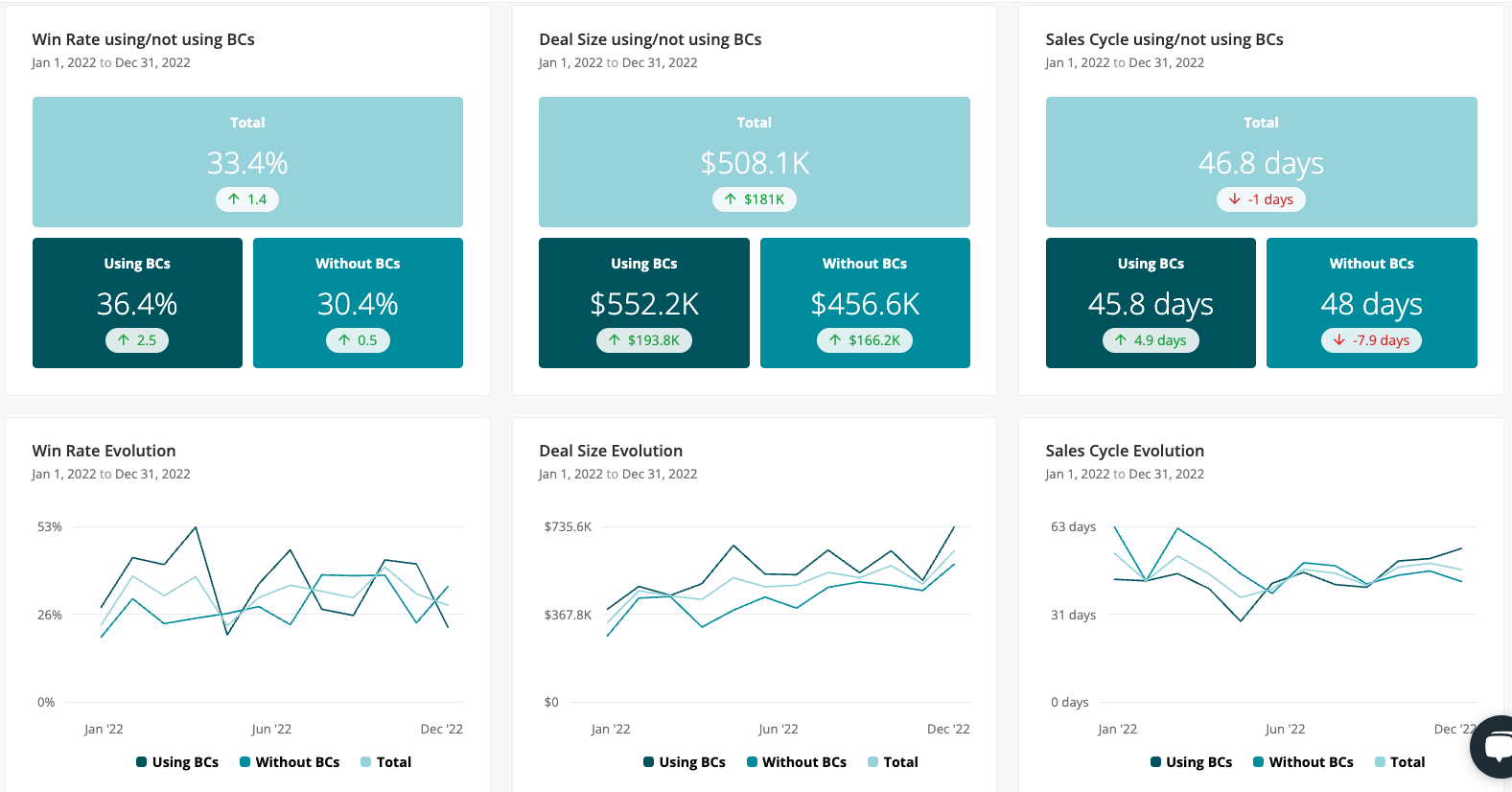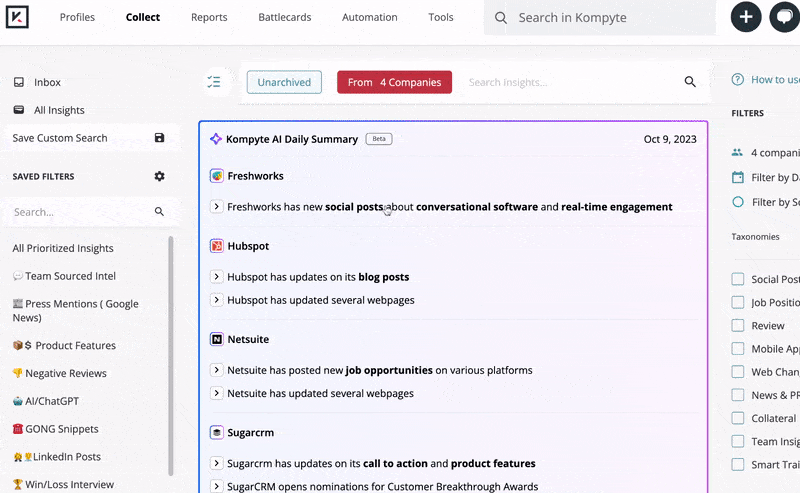How to Create a Sales Enablement Strategy
Learn how to create a comprehensive sales enablement strategy that empowers your sales team and drives revenue growth. Discover best practices and...
Why are companies moving from sales enablement to revenue enablement? Should yours? And how can competitive intelligence boost revenue enablement? Find out here.

Could you use a little revenue lift? If not, please share your secret. 😉 If so, and you’re looking for an out-of-the-box method, revenue enablement might be exactly what you need.
According to Gartner data, organizations prioritizing revenue enablement are 80% more likely to exceed revenue growth targets. Hello!
This article will explain how revenue enablement differs from other organizational functions (such as sales enablement), how it helps drive revenue, and how competitive intelligence can fuel revenue enablement success.
Revenue enablement is a strategic approach that aligns all your teams to maximize revenue generation throughout the customer journey.
Think way beyond an all-hands meeting or company retreat. Revenue enablement happens all day, every day, with each revenue-generating team sharing the same data, content, training, and customer insights.
More sharing means fewer silos. And fewer silos means more efficiency. And with more efficiency, transparency, and consistency among teams comes a greater opportunity to increase revenue across the board.
Sales means money. As does revenue. So, it's understandable that sales enablement can be easily confused with revenue enablement.
Luckily, there's an easy way to understand the difference between the two terms.
Sales enablement focuses on optimizing the sales process to shorten the sales cycle and increase revenue. This function gives the sales team training, tools, and materials for each sales rep to meet their revenue goals.
Many organizations start out with sales enablement. But as they scale, organizations look to more ambitious revenue goals. At this stage, many businesses transform sales enablement into revenue enablement.
Revenue enablement works with all teams that contribute to generating revenue. Like sales enablement, revenue enablement is tasked with helping the sales team. But revenue enablement also provides resources to all other departments in the company that contribute to driving revenue, such as:
Without revenue enablement, these teams are often pushed to the sidelines when discussing increasing the top or bottom line. Yet, those who consider the sales team the sole source of revenue miss out on other revenue-driving opportunities throughout the buyers' journey.
Revenue enablement takes a more holistic approach to driving revenue. If your team contributes to bringing in money to the company, you have a seat at the revenue enablement table.
Revenue enablement and revenue operations also deserve a "what's the difference?" explanation.
While both functions span across all revenue-generating teams, what each function does with these teams varies.
As a refresher, revenue enablement equips sales, marketing, and customer success teams with the tools, information, and resources they need to increase revenue. The goal of revenue enablement is to give these teams what they need to close deals, upsell, cross-sell, and retain customers.
Revenue operations optimize revenue growth in a more big-picture way. Unlike revenue enablement, RevOps focuses on strategic planning and forecasting, optimizing the tech stack, and managing customer and revenue data.
Revenue enablement works with revenue operations to create an enablement tech stack (CRM, content management, competitive intelligence, project management) that best allows their teams to access, share, and store enablement materials effectively. The two functions also collaborate on quarterly or yearly planning and budgeting.
When done well, revenue enablement efforts benefit your organization, prospects, and customers.
Instant pulse check. With access to data from all revenue-generating teams, your company gains greater insights across the customer journey. With these insights, each team can double down on what works and develop new approaches for what falls short of expectations.
Delighted buyers. Prospects and buyers love the consistency that comes with aligning teams throughout their journey. That's good news for you, as happy prospects are more apt to close quickly. A great customer experience also helps your customer retention rates -- better known as "money in the bank with opportunities to increase revenue with upsells."
"When we invest in revenue enablement at Salsify, it's really about making sure our customers have a top-notch buying experience. The more our revenue teams know, the better our conversations become, leading to faster answers and a clearer understanding of the value we can help build. A consistent and always-improving approach transforms our reps into trusted consultants.” Jenna Cope, Director of Global Revenue, Salsify
Marketing and sales in alignment. Might your sales and marketing teams squabble with each other every once in a while? That common sales-marketing tension gets squashed with revenue enablement.
Alex Kracov, CEO of Dock, explains that with revenue enablement at his previous company, Lattice,
"We didn’t worry about whether a lead came from inbound or outbound. We worked together to create marketing campaigns leading to booked meetings. We made product marketing collateral to help the sales team push deals across the finish line." Alex Kracov, CEO, Dock
With marketing and sales now strategically banding together toward a common goal -- making more money --the relationship between the two teams is more collaborative than combative.
By now, you should be pumped to:
So, let's talk about how to start a revenue enablement from scratch.
Get ready to ask questions. Lots of them.
The more you learn about your organization's ideal buyer and how each team interacts with them, the more impactful your revenue enablement efforts will be.
These discovery sessions also get your key stakeholders vested in revenue enablement from Step One. After all, you can only get whole teams to collaborate if you get buy-in from their leaders. So, speaking with them early is crucial to get everyone aligned at the outset.
Organize your questions into three buckets: team expectations, customer expectations, and resource gaps.
Have the stakeholders think about everything from marketing content to sales playbooks to training. Discover what's been most effective here in helping their teams drive revenue – while keeping a consistent, satisfying customer experience in mind. Then, uncover what new resources these teams need to crush their KPIs.
Once you've gathered your intel from internal stakeholders, it's time to build your revenue enablement plan.
Map your priorities. Your stakeholder discovery will give you a heap of resources that need to be built or revised. Determine which of these resources should happen first, who'll be the project liaison for those resources, and how these resources will be tied to revenue.
Evaluate your tech stack. Are all teams using this same CRM, content management system, project management system, and customer success management tools? Ideally, you want all revenue-generating teams to work from the same tools. Work with your RevOps contact to make any necessary tech stack adjustments and create a metrics dashboard that's visible to all the revenue-driving teams.
Decide on touchpoints. How often will you connect with stakeholders? Alignment depends on regularly scheduled check-ins to:
Iterate and optimize. Be prepared not to get your first few efforts perfect. All your stakeholders and revenue-generating teams are getting used to a new way of working together. Take the feedback you get at your stakeholder touchpoint sessions and revise existing or create new materials to maximize your revenue gains.
Even once your company gets the hang of revenue enablement, market forces or internal shifts might dictate that enablement look slightly different. Be open to this reality and adjust accordingly.
In determining your revenue enablement tech stack, be sure to include a competitive intelligence tool.
Competitive intelligence is a major element in providing consistency to all your revenue-driving teams. This intel informs everything from messaging and positioning on landing pages to handling sales objections to saving churn risks.
The features of the competitive intelligence tool Kompyte give you the consistency and transparency needed for your new cross-functional initiatives to succeed.
Its Battlecards allow all teams to understand the company's positioning versus each competitor, why you win in deals and ways to handle the toughest competitive questions. And here's a bonus -- Kompyte's Win/Loss Analysis shows when Battlecards were used in winning deals.

The tool's AI daily summary gives your teams an instant snapshot of what's happening with competitors. This information lets you know if your current revenue enablement efforts are on target or need adjustment.

Revenue Enablement is essential for sustainable growth, streamlining efficiency, and fostering collaboration across teams. Competitive intelligence tools further amplify its effectiveness, offering valuable market insights. This dynamic strategy requires ongoing stakeholder engagement and revising but pays off in a big way by maximizing revenue across the board.
Learn how to create a comprehensive sales enablement strategy that empowers your sales team and drives revenue growth. Discover best practices and...
Learn the basics of sales enablement and how it can help your sales team close more deals. This guide covers the definition, strategies, and best...
Evaluate the top competitive intelligence tools to find the right one for your business. Get detailed information on the functions, data sources,...
Be the first to know about new B2B SaaS Marketing insights to build or refine your marketing function with the tools and knowledge of today’s industry.